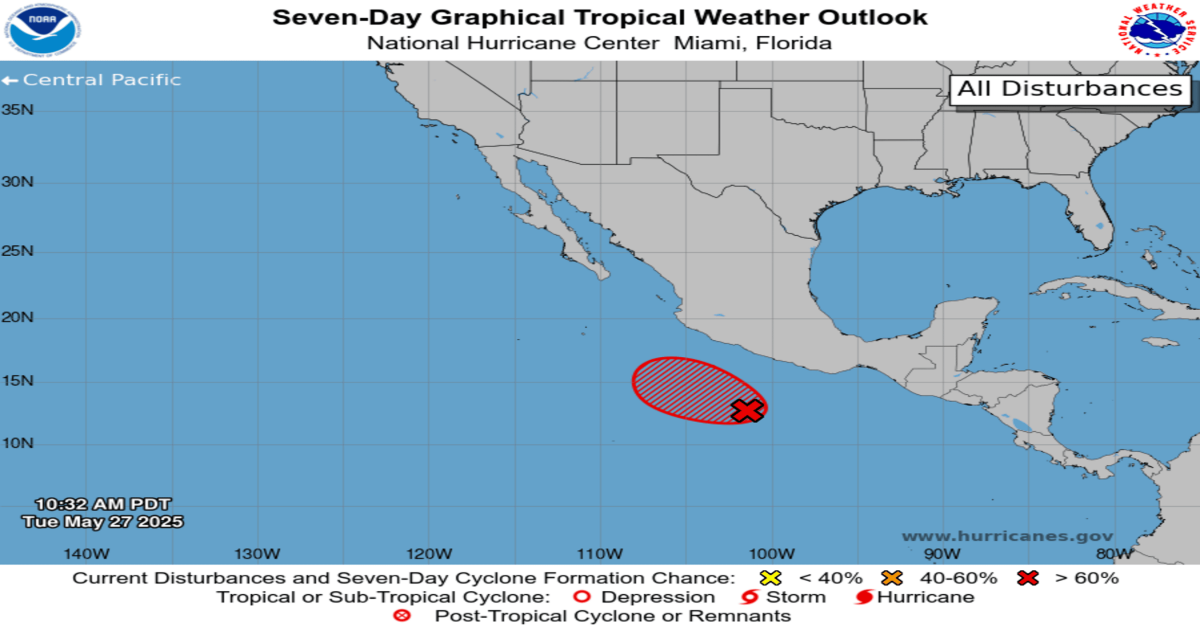There is a “near 100 percent” chance that a tropical depression or tropical storm will form in the Eastern Pacific within the next 48 hours, with National Hurricane Center (NHC) experts anticipating the storm to track west-northwestward.
Why It Matters
When it comes to hurricanes, U.S. forecasts often focus on the Atlantic hurricane season, given that storms in this region can frequently impact coastal states. However, Pacific hurricanes and tropical storms can also pose a risk.
The Eastern Pacific hurricane season began on May 15, two weeks earlier than the Central Pacific and Atlantic hurricane seasons, which start on June 1. Each hurricane season runs through November 30.
What to Know
NHC experts began tracking the potential storm earlier this month. Should it form, it will be the first tropical storm of the Eastern Pacific hurricane season.

A map from the National Hurricane Center shows the anticipated path should a tropical storm form. A map from the National Hurricane Center shows the anticipated path should a tropical storm form. National Hurricane Center
As of Tuesday afternoon, there were no tropical depressions, tropical storms or hurricanes anywhere in the Atlantic or Pacific oceans. However, a disturbance is stirring off the southern coast of Mexico, according to the NHC’s forecast page.
The chances that the storm will develop have increased, with NHC experts predicting a near 100 percent possibility that it will form within the next two days. The storm’s path is taking it away from Mexico and further into the Eastern Pacific.
“Showers and thunderstorms are gradually becoming better organized near a broad area of low pressure located several hundred miles south of the coast of southern Mexico,” the NHC forecast said.
When reached for comment, the NHC referred Newsweek to the National Oceanic and Atmospheric Administration’s (NOAA) 2025 Eastern Pacific hurricane season outlook.
NOAA is forecasting a below-normal hurricane season for the Eastern Pacific with 12 to 18 named storms. Of those, five to 10 will likely become hurricanes, and two to five could develop into major hurricanes.
An average season produces 15 tropical storms and four hurricanes, AccuWeather reported.
Meteorologists are anticipating an active season for the Atlantic Ocean, with 13 to 19 named storms, including six to 10 hurricanes and three to five major hurricanes.
What People Are Saying
The National Hurricane Center, in a tropical weather discussion: “While the system currently lacks a well- defined circulation, environmental conditions are favorable for further development, and a tropical depression or tropical storm is expected to form during the next day or two as the low moves generally west- northwestward at around 5 to 10 kt. There is a high chance of tropical formation within the next 48 hours.”
The forecast added: “Regardless of development, this system will bring numerous showers and thunderstorms along with higher winds and seas to portions of the offshore waters from Oaxaca to Jalisco through late week.”
NOAA said in its Eastern Pacific hurricane outlook: “Hurricane-related disasters can occur during any season, even for years with low overall activity. It only takes one hurricane (or tropical storm) to cause a disaster. It is crucial that residents, businesses, and government agencies of coastal and near-coastal regions prepare for every hurricane season regardless of this, or any other, seasonal outlook.”
What Happens Next
The NHC will continue monitoring the disturbance in the Eastern Pacific. Should the disturbance strengthen into a tropical storm, regular updates about its path will be issued.
